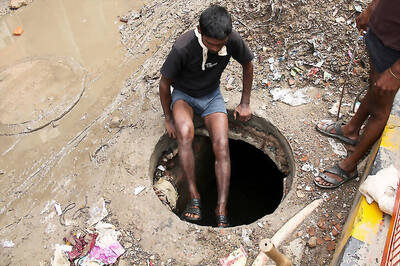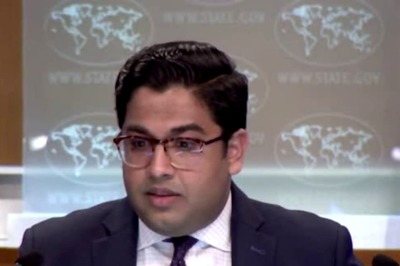
views
The Railways are a state within a state with the attitude of a village. Successive railway ministers in the past two decades, most notably Mamata Banerjee and Ram Vilas Paswan, have driven the Railways to rack and ruin. Commentators in the media have excoriated them and rightly so. But the faceless gnomes of the Railway Board cannot escape blame for hollowing out the organisation from within. They are unworthy of the trust reposed in them.
Is it not truly a disgrace that an organisation with $23 billion in annual revenue should allow open defecation when eradication of the practice is a national priority? Can there be anything more primitive than the sight of toilet droppings in railway stations? Would it be an exaggeration to suggest that the Railways are the single largest institutionalised carriers of disease, considering that they move the equivalent of the nation once in 50 days or 2 per cent of the population every day? Installation of no-discharge vacuum toilets or safe discharge ones that employ microbes does not require huge financial outlay.
But the Railway Board is so blasé that it has been 'experimenting' with various technologies 'for quite some time.' Stop fiddling and start getting real, a safety committee, appointed by minister Dinesh Trivedi, told the Board last month. It has set a deadline of five years for installation of green toilets in all 43,000 coaches at a cost of Rs 3,000 crore. Toilet droppings are also a hazard – they corrode rails and result in poor maintenance of undercarriages of trains, which railwaymen avoid because of 'inhuman unhygienic conditions.' That it requires nuclear scientist Anil Kakodkar and 'Metroman' E Sreedharan to prod the Board into doing the obvious shows how out of sync with the times its sensibilities are.
The same indifference informs the Railway Board's outlook to passenger comfort. If India is 'emerging', do not look for signs of it in railway stations. The sight of passengers, many of them old and week-kneed, denied trolleys, lifts and escalators and hauling themselves and their luggage over steep stairs belongs to a Dickensian world. But elevated concern cannot be expected from officials who care little even for the safety of people entrusted to their care. In the 36 months to last April, accidents claimed a little over a thousand passenger lives. Double of that number were injured. Talk about accidents and the Railways will smugly show you a graph of the declining trend of incidents per million train kilometres.
What they will not tell you is that more staff get killed or hurt than passengers. The Kakodkar committee was appalled to find that employee casualties were 'markedly high.' In the 43 months to last October, 1,600 of them died, an average of one a day. And on each of those days, 202 (or 8,700 in total) got injured. What kind of leadership tolerates such a record? Track maintenance staff is the most endangered. Mechanisation of activity in this high-risk area is the obvious solution. It should have been articulated as a non-negotiable demand and implemented by the Railway top management. Does it have to await the recommendation from a committee of experts?
For the Railways, evasion comes easier than action. The Kakodkar committee believes that 15,000 people get killed every year; 6,000 of them in Mumbai alone while crossing the tracks or living alongside them. The Railways consider most of them to be trespassers and does not own up to the deaths. Liability can be denied but not responsibility. The Kakodar panel is appalled. No civilised society can accept such massacre on the railway system. The tab for fencing the tracks in populated areas and eliminating all level crossings is stiff: Rs 50,000 crore. But if the Railways had the inclination, they would have found the money, realising that this measure would pay for itself within eight years in repairs not undertaken and downtime saved.
Sadly, the people you entrust your lives with do not care for you. There is no culture of safety in the Railways. Trains run at speeds (of 80-100 km an hour) that coaches are not designed for. Experts say Integral Coach Factory designs are a 'serious safety risk' beyond 56 kmph. They do not have casualty minimising anti-climbing features of the German design coaches manufactured in Kapurthala and deployed on Rajdhanis and Shatabdis. About 43,000 such unsafe coaches are in use and continue to be produced.
Quality norms are not adhered to even in the procurement of critical components. Pivotal fasteners in new coaches at the Kapurthala factory were found to be substandard. Air brakes are supposed to retain effective pressure for 15 hours even when they spring a leak. When wagons were tested at a railway laboratory, the brakes gave way in half an hour. Roller bearing failure due to overheating is another hazard in Rajdhani coaches. A 'simple low cost device' like a bimetal sensor can flash red and sound an alarm. In a culture of safety, such suggestions would not have to come as expert advice.
Despite the use of fire retardant materials, the risk cannot be ignored. Fire extinguishers are 'rudimentary and insufficient,' says the Kakodar committee. Smoke detectors do not work on running trains, so flame detectors have been recommended. But once an alert is sounded, can passengers bail out safely? Aircraft are designed to evacuate people within 90 seconds. Indian Railways has no such protocol. Passengers are supposed to jump out of emergency windows, braving fractures and sprains. Collapsible ladders? What's that? There is not a standard list of safety components. The number varies from six in the western railway to 993 in the central zone. In the eastern and north-western zones, there is no such category.
The Kakodkar committee says the Railways suffer from an 'implementation bug.' Even accepted recommendations of previous safety committee have not been executed. The Railways are 'experimenting' with the anti-collision device for ten years. The train protection and warning system based on European standards has not been customised. A 10,000 ton sample of high stress alloy rails is being tested – the deadline for completion is 2015, which the Kakodkar panel found to be exasperatingly slow. The safety commissioner is an employee with limited mandate, whose observations the Board can overrule. There is no maintenance protocol for heavy duty stretches because of the constant movement of trains.
Money is no doubt a constraint. But a culture of safety needs sensitivity, discipline and empowerment of people – missing pieces all in the Railways.
The Kakodkar panel estimates that a little over Rs one lakh crore will be needed to improve safety. This is where the Board hits a political wall. Fares have not been raised for a long time. Even if they were, they would not yield much. But what has the Board done to pluck the resources within easy reach? The railways sit on huge tracks of land in prime areas. They can sell airspace in stations. This is how the Delhi Metro has met a small part of its investment. This is how the modernisation of Delhi and Mumbai airports has been funded. In Hong Kong, Singapore and China, investment for infrastructure comes from property development. But our Railway Board gives in to the objections of Delhi's obstructive civic agencies rather than use ministerial clout – and railway ministers are powerful allies – to brow beat them and proceed with modernisation of New Delhi railway station. An independent tariff regulator (as in the electricity and aviation sectors) would have aided the Board in fare and freight revision by taking some of the politics out. But it is vehemently opposed to the same. Despite running low on finances, it tries to trip ready and willing multinational investors in engine manufacture. Accounting reforms have been going on since 2005. The Railway balance sheet does not present a true and fair picture because liabilities are not accounted for, as they arise only when they are paid for.
No great idea has come from the Railway Board in recent years. At the beginning of the last decade, the Rakesh Mohan committee said the Railways should be recast along business lines (freight, passenger, rolling stock, tracks) and along functions (electrical, mechanical). The Railways organised numerous workshops and created internal opposition to the advice. The dedicated freight corridor was an idea of the Planning Commission which the Prime Minister adopted as his agenda, but the Railway Board ensured that it was not executed in private partnership. The result is that the project is languishing.
Railway Board members are good at operating trains. But management of such a vast and important public enterprise needs vision, clarity, ambition and high-mindedness. Leaders should be able to 'manage the boundaries' (the external environment). This is an art that escapes the Railway bureaucracy. It cares for little else than power, pay, perks, and pension. The populism of railway ministers actually plays into its hands. When social obligations are announced, fares are not revised and funds get depleted, it can throw up its hands and avoid accountability.
If minister Dinesh Trivedi presents a budget that harms the Railways, skewer him by all means. But do not spare the gnomes in the holes. They would rather see the enterprise fail than lose hold of the system.




















Comments
0 comment